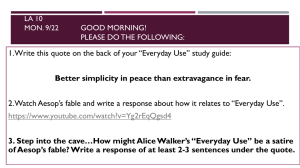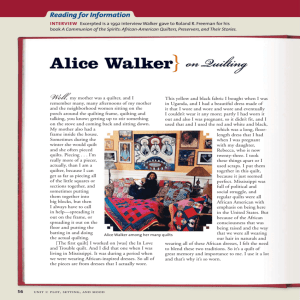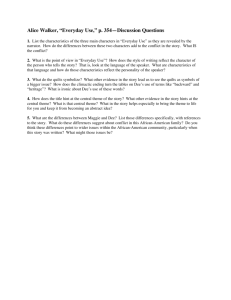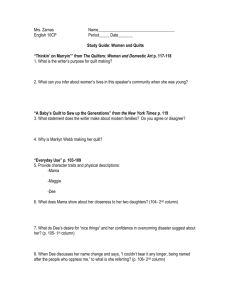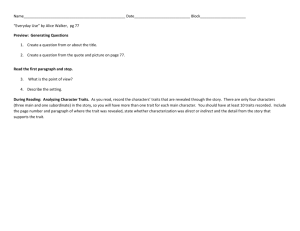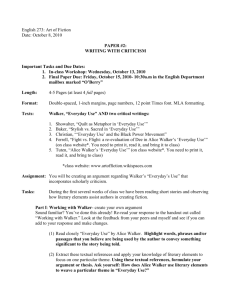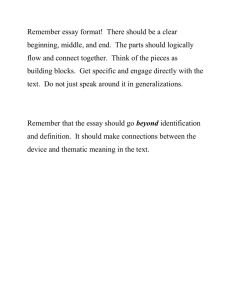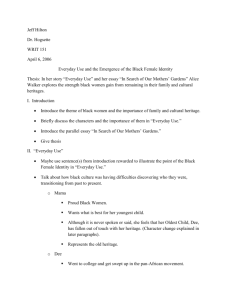Alice Walker's Everyday Use: Quilts, Identity, and Heritage
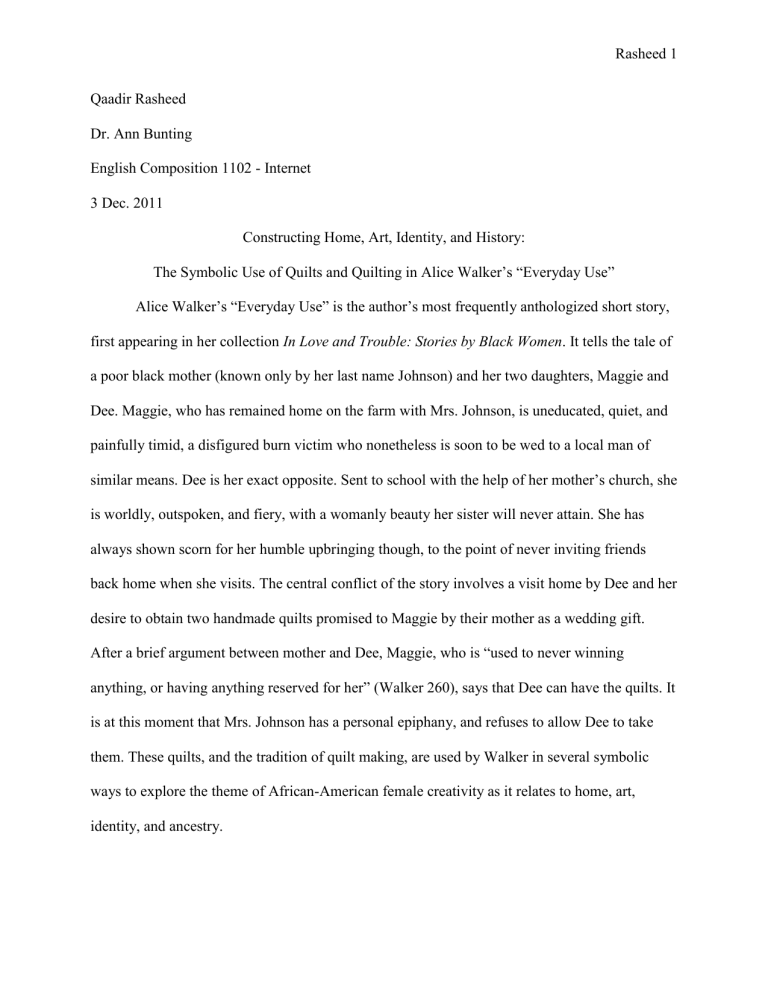
Rasheed 1
Qaadir Rasheed
Dr. Ann Bunting
English Composition 1102 - Internet
3 Dec. 2011
Constructing Home, Art, Identity, and History:
The Symbolic Use of Quilts and Quilting in Alice Walker’s “Everyday Use”
Alice Walker’s “Everyday Use” is the author’s most frequently anthologized short story, first appearing in her collection In Love and Trouble: Stories by Black Women . It tells the tale of a poor black mother (known only by her last name Johnson) and her two daughters, Maggie and
Dee. Maggie, who has remained home on the farm with Mrs. Johnson, is uneducated, quiet, and painfully timid, a disfigured burn victim who nonetheless is soon to be wed to a local man of similar means. Dee is her exact opposite. Sent to school with the help of her mother’s church, she is worldly, outspoken, and fiery, with a womanly beauty her sister will never attain. She has always shown scorn for her humble upbringing though, to the point of never inviting friends back home when she visits. The central conflict of the story involves a visit home by Dee and her desire to obtain two handmade quilts promised to Maggie by their mother as a wedding gift.
After a brief argument between mother and Dee, Maggie, who is “used to never winning anything, or having anything reserved for her” (Walker 260), says that Dee can have the quilts. It is at this moment that Mrs. Johnson has a personal epiphany, and refuses to allow Dee to take them. These quilts, and the tradition of quilt making, are used by Walker in several symbolic ways to explore the theme of African-American female creativity as it relates to home, art, identity, and ancestry.
Rasheed 2
A quilt is such a simple thing, intended to provide warmth and comfort for the home, but the process of quilting, the sewing together of disparate scraps of tattered worn out clothing, can be said to reflect the daily experiences of many black women of this story’s time. Lacking options, these women took what little life had to offer and made it work for them, creating home from what was close at hand, or as Houston A. Baker, Jr. and Charlotte Pierce-Baker state so eloquently in their critique “Patches: Quilts and Community in Alice Walker’s ‘Everyday Use’”:
All the dark, southern energy that manifests itself in the conversion of a sagging cabin – a shack really – into a “happy home” by stringing a broom wire between two nails in the wall and making the joint jump, or that shows itself in the “crazy quilt” patched from crumbs and remainders, seems but a vestige of outmoded and best-forgotten customs (310).
Walker touches on this idea of the unfashionable and passé when Mrs. Johnson reflects that Dee had a chance to have the quilts once before. “I didn’t want to bring up how I had offered
Dee (Wangero) a quilt when she went away for college. Then she had told me they were oldfashioned, out of style” (259). Then, as now, Dee has no appreciation of the effort and sacrifice, performed by generation after generation of Southern black women, involved in the conversion of tattered remnants into items of everyday use.
What Dee does limitedly seem to appreciate (an idea Walker explores more thoroughly) is the “art” of the quilt, although her appreciation comes in the form of haughty pretence. Dee
“rightly recognizes the quilts as part of a fragile heritage, but she fails to see the extent to which she herself has traduced that heritage” observes David Cowart in his essay “Heritage and
Deracination in ‘Everyday Use’” (22). To her the quilts are just another accessory, like her kente dress and Muslim affectations, of the “back to Africa” movement rolling through America at the
Rasheed 3 time. What she fails to recognize is the deeper artistry involved, the pent-up expression of creativity that all women, and particularly African-American women, have been forced to navigate. In her article “Alice Walker: In Praise of Maternal Heritage” Gail Keating elucidates on the difficulties women have had in finding artistic outlets, being constrained as they often are by the demands of children, work, and home, and having that creativity be recognized. “Alice
Walker looks at the tremendous burden black women have had to carry from a historical perspective and analyses the overwhelming odds they have had to overcome to express their creativity.” Commenting on a quilt that hangs in the Smithsonian Institution, Walker states:
In fanciful, inspired and yet simple and identifiable figures, it portrays the story of the Crucifixion. It is considered rare, beyond price. Though it follows no known pattern of quilt making, and although it is made of bits and pieces of worthless rags, it is obviously the work of a person of powerful imagination and deep spiritual feeling. Below this quilt I saw a note that says it was made by “an anonymous black woman in Alabama, a hundred years ago.”
If we could locate this “anonymous” black woman from Alabama, she would turn out to be one of our grandmothers – an artist who left her mark in the only materials she could afford, and in the only medium her position in society allowed her to use. (qtd. in Keating)
Now this is not to say that every quilter desired to achieve the creative status of this unknown woman, yet creativity is an inherent aspect of being human, and one that has a strong impact on personal identity. Walker plays with this notion efficiently in the following exchange:
“You just don’t understand,” she said, as Maggie and I came out to the car.
Rasheed 4
“What don’t I understand?” I wanted to know.
“Your heritage,” she said. And then she turned to Maggie, kissed her, and said,
“You ought to try to make something of yourself, too, Maggie. It’s really a new day for us. But from the way you and Mama live you’d never know it” (260).
But what Dee doesn’t grasp is that Maggie and Mama have long ago made something of themselves. “It was Grandma Dee and Big Dee who taught her how to quilt herself.” Mrs.
Johnson reminisces. According to Baker and Pierce-Baker:
The conjunction of “quilt” and “self” in Walker’s syntax may be simply a serendipitous accident of style. Nonetheless, the conjunction works magnificently to capture the force of black woman’s quilting in “Everyday Use.” Finally, it is the “self”, or a version of humanness that one calls the Afro-American self, that must, in fact, be crafted from fragments on the basis of wisdom gained from preceding generations (314).
This brings us finally to the quilt as historical record: a utilitarian family tree. Although
Maggie will put the quilts into everyday use, likely decreasing their lifespan, one can just imagine Maggie and Mama teaching the next generation how to craft a quilt from its remnants, imparting the histories of the pieces and scraps of cloth, passing on knowledge of stitching and construction, sitting and remembering the generations past. Says Abby H. P. Werlock, “Although readers can sympathize with Dee’s desire to improve her situation and to feel pride in her
African heritage, Walker also makes clear that in rejecting the African-American part of that heritage, she loses a great deal.” It is no wonder, then, that Mrs. Johnson decided to snatch the
Rasheed 5 quilts away from Dee. In her hands the knowledge and tradition would, if not die, then definitely stagnate, framed, on a wall.
Rasheed 6
Works Cited
Baker, Houston A., and Charlotte Pierce-Baker. “Patches: Quilts and Community in Alice
Walker’s ‘Everyday Use.’”
Alice Walker: Critical Perspectives Past and Present.
Ed.
Henry Louis Gates, Jr. and K. A. Appiah. New York: Amistad, 1993. 309-16. Print
Cowart, David. “Heritage and Deracination in Walker’s ‘Everyday Use.’”
Critical Essays on
Alice Walker. Ed. Ikenna Dieke. Westport: Greenwood, 1999. 21-32. Print
Keating, Gail. “Alice Walker: In Praise of Maternal Heritage.” The Literary Griot: International
Journal of Black Expressive Cultural Studies 6.1 (1994): 26-37. Rprt. in “Alice Walker:
In Praise of Maternal Heritage.”
Alice Walker, New Edition. Ed. Harold Bloom. New
York: Chelsea PH, 2009.
Bloom’s Literary Reference Online.
Web. 10 November 2011.
Walker, Alice. “Everyday Use.”
Lit.
Ed. Laurie G. Kirszner and Stephen R. Mandell. Boston:
Wadsworth, 2012. 256-60. Print
Werlock, Abby H. P. “Everyday Use.”
The Facts on File Companion to the American Short
Story, Second Edition. (2009): n. pag.
Bloom’s Literary Reference Online.
Web. 10
November 2011.
